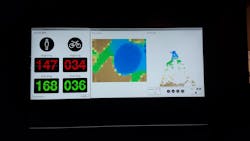Mobile Passenger Counting and Bicycle Counting with IRMA
Automated passenger counting assesses the degree of utilization of public transportation vehicles on buses and trains affordably, reliably and permanently. Gathering data on the actual usage of different lines depending on the time of day and day of the week provides the basis for demand-actuated route planning, optimal occupancy rates and the accounting of transport services.
IRMA is constructed for use in vehicles and is highly resilient to tough environmental conditions, such as temperature, humidity and vibration. The sensor is installed above the door, when possible behind the vehicle paneling.
The IRMA 3D system employs a laser light pulsing in short succession in the invisible IR range, which is reflected by objects and registered by the detector. By measuring the time span between the emission and reception of the light impulse, the distance to the object is calculated. In this way, the system generates a 3D image of the door area. Even in dense crowds, individual passengers are recognized and counted accurately. The raw data is more than 96 percent accurate and independent of environmental conditions.
With the IRMA Matrix system, Iris GmbH created a revolutionary product for passenger counting, further developing the IRMA 3D sensor's measuring principle. A sensor matrix with 500 pixels measures the distance to the object and captures it in 3-D. This is made possible with the innovative time-of-flight technology. It uses the phase difference between the signals sent out and decoded by the sensor in measuring the distance to the object through the signal's transit time. This makes it possible to determine, with the highest degree of accuracy, the physical presence and movement of persons in the field of vision. The result is high-precision measurement with defined absolute accuracy.
A Wheel Length Ahead
With the Bicycle Counting Feature of the IRMA Matrix, the time-of-flight sensor for passenger counting, Iris GmbH provides transit operators with a tool for accurate estimation of required bicycle transportation capacity.
The technology enables the transmission of the actual availability of bicycle transportation capacities in real time. The real-time data could be accessed by cyclists via their cell phone, while the capacity information feature can be managed and controlled by the transit operator.
Utilizing this technology, bicycle allocation at transit platforms can be controlled to achieve optimum distribution to available bicycle spaces.
The Bicycle Counting Feature is software that can be uploaded to the IRMA Matrix sensor.
